Pediatrics Article Analysis: SSRI Use, ASD, and Developmental Delay
VerifiedAdded on 2020/03/16
|6
|2033
|50
Homework Assignment
AI Summary
This homework assignment presents an in-depth analysis of the research article by Harrington et al. (2014) published in Pediatrics, which investigates the association between prenatal use of selective serotonin reuptake inhibitors (SSRIs) and the risk of autism spectrum disorder (ASD) or developmental delay in offspring. The analysis meticulously examines the study's methodology, including the case-control design, study population, and recruitment of cases and controls. It identifies potential biases, such as selection bias and recall bias, and evaluates their impact on the study's internal validity and generalizability. The analysis further explores the study's findings, including measures of association, definitions of SSRI use and ASD, and the influence of confounders and effect modifiers like child gender. The assignment also compares the study's results with those of other research and discusses the application of Bradford Hill criteria for establishing causality. The analysis concludes by assessing the study's limitations and strengths, providing a comprehensive understanding of the complex relationship between prenatal SSRI exposure and offspring neurodevelopmental outcomes.
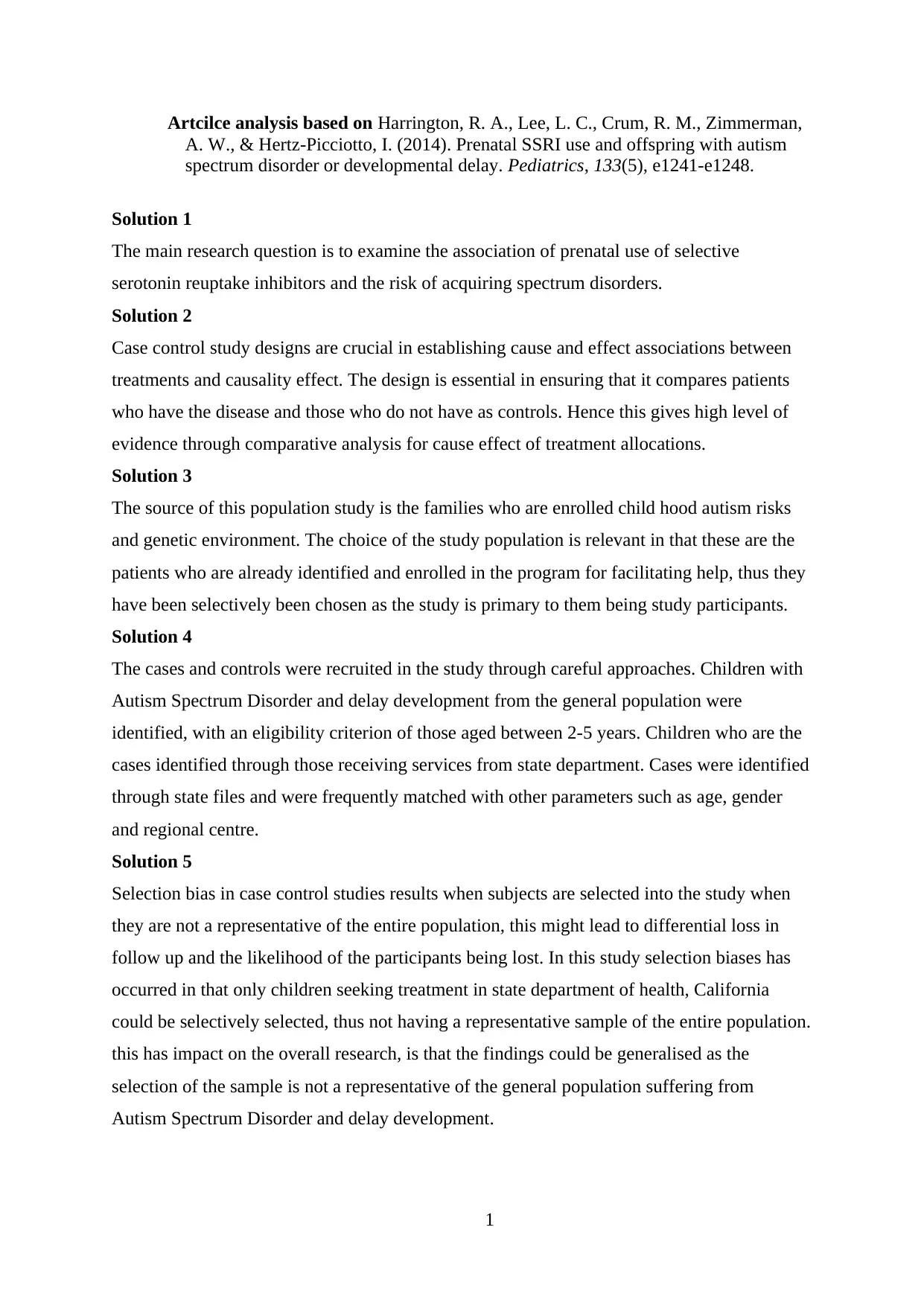
Artcilce analysis based on Harrington, R. A., Lee, L. C., Crum, R. M., Zimmerman,
A. W., & Hertz-Picciotto, I. (2014). Prenatal SSRI use and offspring with autism
spectrum disorder or developmental delay. Pediatrics, 133(5), e1241-e1248.
Solution 1
The main research question is to examine the association of prenatal use of selective
serotonin reuptake inhibitors and the risk of acquiring spectrum disorders.
Solution 2
Case control study designs are crucial in establishing cause and effect associations between
treatments and causality effect. The design is essential in ensuring that it compares patients
who have the disease and those who do not have as controls. Hence this gives high level of
evidence through comparative analysis for cause effect of treatment allocations.
Solution 3
The source of this population study is the families who are enrolled child hood autism risks
and genetic environment. The choice of the study population is relevant in that these are the
patients who are already identified and enrolled in the program for facilitating help, thus they
have been selectively been chosen as the study is primary to them being study participants.
Solution 4
The cases and controls were recruited in the study through careful approaches. Children with
Autism Spectrum Disorder and delay development from the general population were
identified, with an eligibility criterion of those aged between 2-5 years. Children who are the
cases identified through those receiving services from state department. Cases were identified
through state files and were frequently matched with other parameters such as age, gender
and regional centre.
Solution 5
Selection bias in case control studies results when subjects are selected into the study when
they are not a representative of the entire population, this might lead to differential loss in
follow up and the likelihood of the participants being lost. In this study selection biases has
occurred in that only children seeking treatment in state department of health, California
could be selectively selected, thus not having a representative sample of the entire population.
this has impact on the overall research, is that the findings could be generalised as the
selection of the sample is not a representative of the general population suffering from
Autism Spectrum Disorder and delay development.
1
A. W., & Hertz-Picciotto, I. (2014). Prenatal SSRI use and offspring with autism
spectrum disorder or developmental delay. Pediatrics, 133(5), e1241-e1248.
Solution 1
The main research question is to examine the association of prenatal use of selective
serotonin reuptake inhibitors and the risk of acquiring spectrum disorders.
Solution 2
Case control study designs are crucial in establishing cause and effect associations between
treatments and causality effect. The design is essential in ensuring that it compares patients
who have the disease and those who do not have as controls. Hence this gives high level of
evidence through comparative analysis for cause effect of treatment allocations.
Solution 3
The source of this population study is the families who are enrolled child hood autism risks
and genetic environment. The choice of the study population is relevant in that these are the
patients who are already identified and enrolled in the program for facilitating help, thus they
have been selectively been chosen as the study is primary to them being study participants.
Solution 4
The cases and controls were recruited in the study through careful approaches. Children with
Autism Spectrum Disorder and delay development from the general population were
identified, with an eligibility criterion of those aged between 2-5 years. Children who are the
cases identified through those receiving services from state department. Cases were identified
through state files and were frequently matched with other parameters such as age, gender
and regional centre.
Solution 5
Selection bias in case control studies results when subjects are selected into the study when
they are not a representative of the entire population, this might lead to differential loss in
follow up and the likelihood of the participants being lost. In this study selection biases has
occurred in that only children seeking treatment in state department of health, California
could be selectively selected, thus not having a representative sample of the entire population.
this has impact on the overall research, is that the findings could be generalised as the
selection of the sample is not a representative of the general population suffering from
Autism Spectrum Disorder and delay development.
1
Paraphrase This Document
Need a fresh take? Get an instant paraphrase of this document with our AI Paraphraser
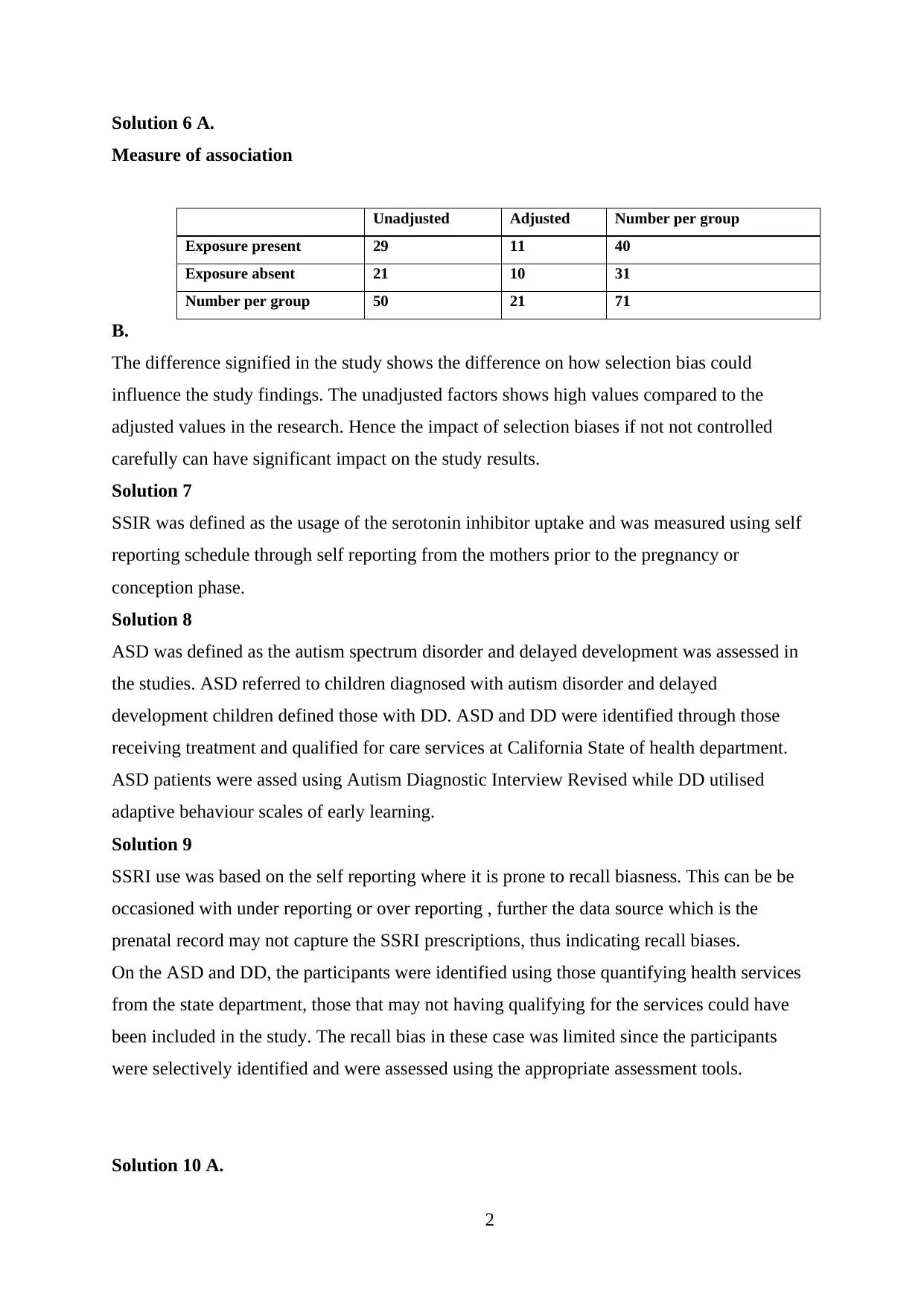
Solution 6 A.
Measure of association
Unadjusted Adjusted Number per group
Exposure present 29 11 40
Exposure absent 21 10 31
Number per group 50 21 71
B.
The difference signified in the study shows the difference on how selection bias could
influence the study findings. The unadjusted factors shows high values compared to the
adjusted values in the research. Hence the impact of selection biases if not not controlled
carefully can have significant impact on the study results.
Solution 7
SSIR was defined as the usage of the serotonin inhibitor uptake and was measured using self
reporting schedule through self reporting from the mothers prior to the pregnancy or
conception phase.
Solution 8
ASD was defined as the autism spectrum disorder and delayed development was assessed in
the studies. ASD referred to children diagnosed with autism disorder and delayed
development children defined those with DD. ASD and DD were identified through those
receiving treatment and qualified for care services at California State of health department.
ASD patients were assed using Autism Diagnostic Interview Revised while DD utilised
adaptive behaviour scales of early learning.
Solution 9
SSRI use was based on the self reporting where it is prone to recall biasness. This can be be
occasioned with under reporting or over reporting , further the data source which is the
prenatal record may not capture the SSRI prescriptions, thus indicating recall biases.
On the ASD and DD, the participants were identified using those quantifying health services
from the state department, those that may not having qualifying for the services could have
been included in the study. The recall bias in these case was limited since the participants
were selectively identified and were assessed using the appropriate assessment tools.
Solution 10 A.
2
Measure of association
Unadjusted Adjusted Number per group
Exposure present 29 11 40
Exposure absent 21 10 31
Number per group 50 21 71
B.
The difference signified in the study shows the difference on how selection bias could
influence the study findings. The unadjusted factors shows high values compared to the
adjusted values in the research. Hence the impact of selection biases if not not controlled
carefully can have significant impact on the study results.
Solution 7
SSIR was defined as the usage of the serotonin inhibitor uptake and was measured using self
reporting schedule through self reporting from the mothers prior to the pregnancy or
conception phase.
Solution 8
ASD was defined as the autism spectrum disorder and delayed development was assessed in
the studies. ASD referred to children diagnosed with autism disorder and delayed
development children defined those with DD. ASD and DD were identified through those
receiving treatment and qualified for care services at California State of health department.
ASD patients were assed using Autism Diagnostic Interview Revised while DD utilised
adaptive behaviour scales of early learning.
Solution 9
SSRI use was based on the self reporting where it is prone to recall biasness. This can be be
occasioned with under reporting or over reporting , further the data source which is the
prenatal record may not capture the SSRI prescriptions, thus indicating recall biases.
On the ASD and DD, the participants were identified using those quantifying health services
from the state department, those that may not having qualifying for the services could have
been included in the study. The recall bias in these case was limited since the participants
were selectively identified and were assessed using the appropriate assessment tools.
Solution 10 A.
2
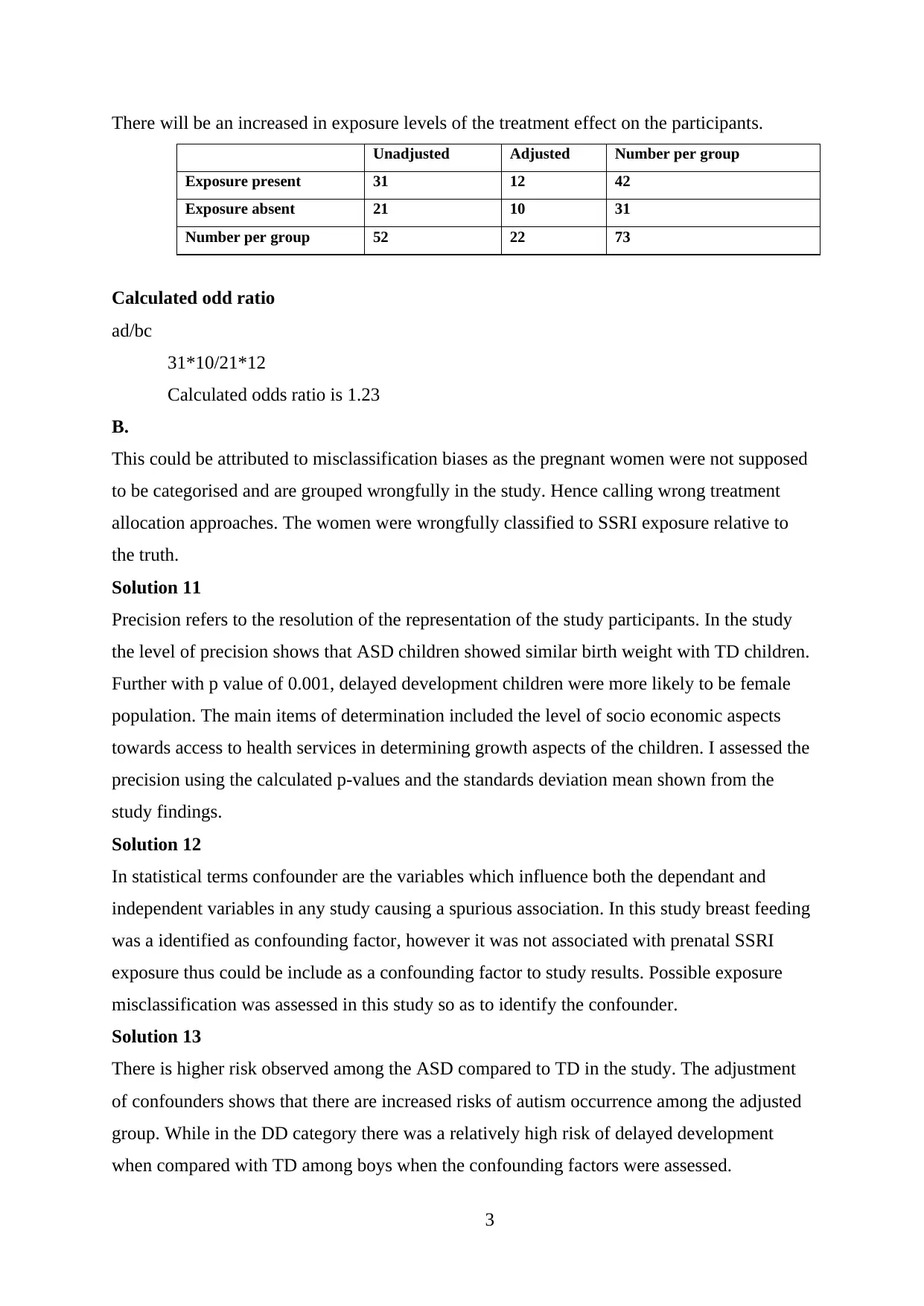
There will be an increased in exposure levels of the treatment effect on the participants.
Unadjusted Adjusted Number per group
Exposure present 31 12 42
Exposure absent 21 10 31
Number per group 52 22 73
Calculated odd ratio
ad/bc
31*10/21*12
Calculated odds ratio is 1.23
B.
This could be attributed to misclassification biases as the pregnant women were not supposed
to be categorised and are grouped wrongfully in the study. Hence calling wrong treatment
allocation approaches. The women were wrongfully classified to SSRI exposure relative to
the truth.
Solution 11
Precision refers to the resolution of the representation of the study participants. In the study
the level of precision shows that ASD children showed similar birth weight with TD children.
Further with p value of 0.001, delayed development children were more likely to be female
population. The main items of determination included the level of socio economic aspects
towards access to health services in determining growth aspects of the children. I assessed the
precision using the calculated p-values and the standards deviation mean shown from the
study findings.
Solution 12
In statistical terms confounder are the variables which influence both the dependant and
independent variables in any study causing a spurious association. In this study breast feeding
was a identified as confounding factor, however it was not associated with prenatal SSRI
exposure thus could be include as a confounding factor to study results. Possible exposure
misclassification was assessed in this study so as to identify the confounder.
Solution 13
There is higher risk observed among the ASD compared to TD in the study. The adjustment
of confounders shows that there are increased risks of autism occurrence among the adjusted
group. While in the DD category there was a relatively high risk of delayed development
when compared with TD among boys when the confounding factors were assessed.
3
Unadjusted Adjusted Number per group
Exposure present 31 12 42
Exposure absent 21 10 31
Number per group 52 22 73
Calculated odd ratio
ad/bc
31*10/21*12
Calculated odds ratio is 1.23
B.
This could be attributed to misclassification biases as the pregnant women were not supposed
to be categorised and are grouped wrongfully in the study. Hence calling wrong treatment
allocation approaches. The women were wrongfully classified to SSRI exposure relative to
the truth.
Solution 11
Precision refers to the resolution of the representation of the study participants. In the study
the level of precision shows that ASD children showed similar birth weight with TD children.
Further with p value of 0.001, delayed development children were more likely to be female
population. The main items of determination included the level of socio economic aspects
towards access to health services in determining growth aspects of the children. I assessed the
precision using the calculated p-values and the standards deviation mean shown from the
study findings.
Solution 12
In statistical terms confounder are the variables which influence both the dependant and
independent variables in any study causing a spurious association. In this study breast feeding
was a identified as confounding factor, however it was not associated with prenatal SSRI
exposure thus could be include as a confounding factor to study results. Possible exposure
misclassification was assessed in this study so as to identify the confounder.
Solution 13
There is higher risk observed among the ASD compared to TD in the study. The adjustment
of confounders shows that there are increased risks of autism occurrence among the adjusted
group. While in the DD category there was a relatively high risk of delayed development
when compared with TD among boys when the confounding factors were assessed.
3
⊘ This is a preview!⊘
Do you want full access?
Subscribe today to unlock all pages.

Trusted by 1+ million students worldwide
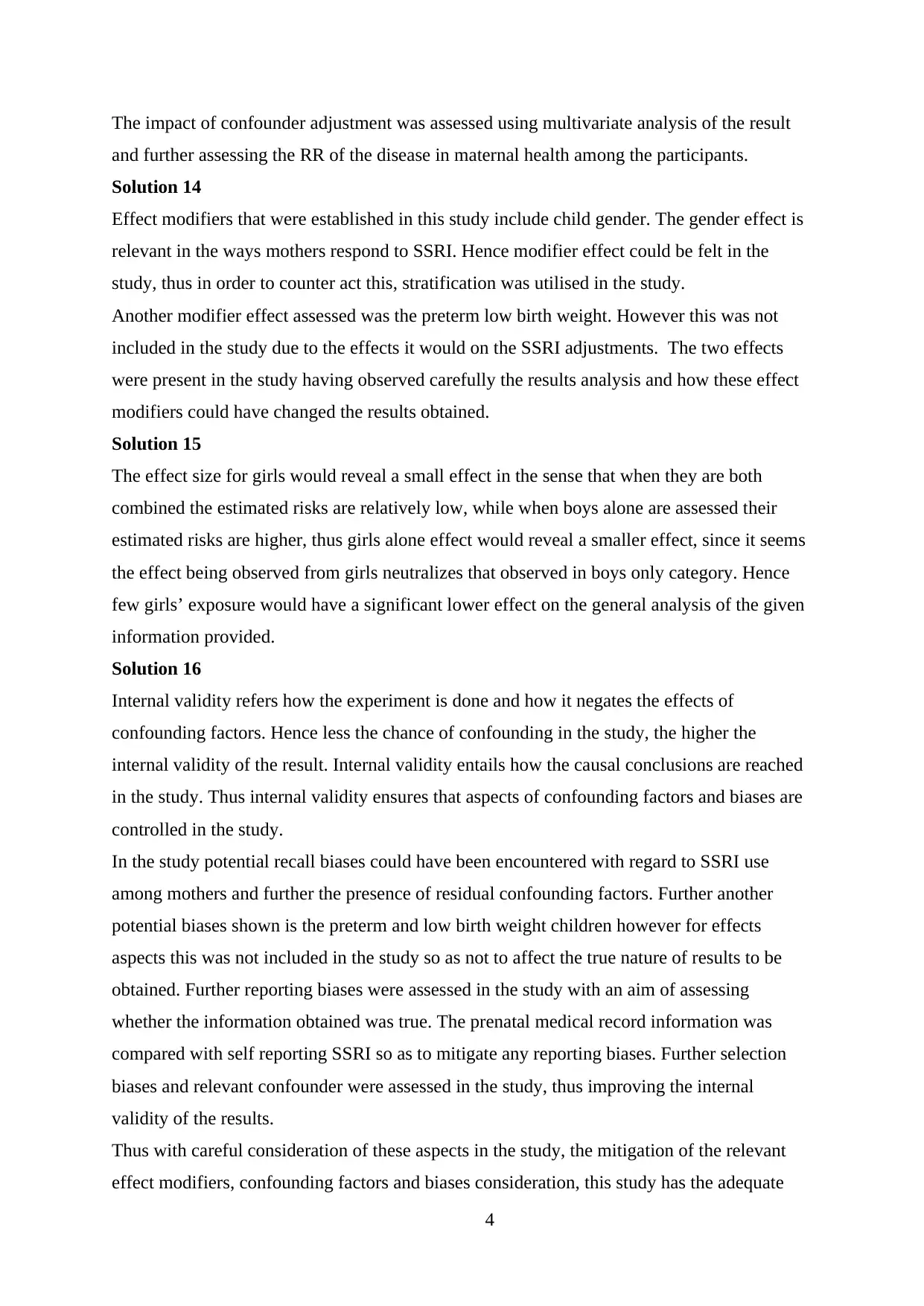
The impact of confounder adjustment was assessed using multivariate analysis of the result
and further assessing the RR of the disease in maternal health among the participants.
Solution 14
Effect modifiers that were established in this study include child gender. The gender effect is
relevant in the ways mothers respond to SSRI. Hence modifier effect could be felt in the
study, thus in order to counter act this, stratification was utilised in the study.
Another modifier effect assessed was the preterm low birth weight. However this was not
included in the study due to the effects it would on the SSRI adjustments. The two effects
were present in the study having observed carefully the results analysis and how these effect
modifiers could have changed the results obtained.
Solution 15
The effect size for girls would reveal a small effect in the sense that when they are both
combined the estimated risks are relatively low, while when boys alone are assessed their
estimated risks are higher, thus girls alone effect would reveal a smaller effect, since it seems
the effect being observed from girls neutralizes that observed in boys only category. Hence
few girls’ exposure would have a significant lower effect on the general analysis of the given
information provided.
Solution 16
Internal validity refers how the experiment is done and how it negates the effects of
confounding factors. Hence less the chance of confounding in the study, the higher the
internal validity of the result. Internal validity entails how the causal conclusions are reached
in the study. Thus internal validity ensures that aspects of confounding factors and biases are
controlled in the study.
In the study potential recall biases could have been encountered with regard to SSRI use
among mothers and further the presence of residual confounding factors. Further another
potential biases shown is the preterm and low birth weight children however for effects
aspects this was not included in the study so as not to affect the true nature of results to be
obtained. Further reporting biases were assessed in the study with an aim of assessing
whether the information obtained was true. The prenatal medical record information was
compared with self reporting SSRI so as to mitigate any reporting biases. Further selection
biases and relevant confounder were assessed in the study, thus improving the internal
validity of the results.
Thus with careful consideration of these aspects in the study, the mitigation of the relevant
effect modifiers, confounding factors and biases consideration, this study has the adequate
4
and further assessing the RR of the disease in maternal health among the participants.
Solution 14
Effect modifiers that were established in this study include child gender. The gender effect is
relevant in the ways mothers respond to SSRI. Hence modifier effect could be felt in the
study, thus in order to counter act this, stratification was utilised in the study.
Another modifier effect assessed was the preterm low birth weight. However this was not
included in the study due to the effects it would on the SSRI adjustments. The two effects
were present in the study having observed carefully the results analysis and how these effect
modifiers could have changed the results obtained.
Solution 15
The effect size for girls would reveal a small effect in the sense that when they are both
combined the estimated risks are relatively low, while when boys alone are assessed their
estimated risks are higher, thus girls alone effect would reveal a smaller effect, since it seems
the effect being observed from girls neutralizes that observed in boys only category. Hence
few girls’ exposure would have a significant lower effect on the general analysis of the given
information provided.
Solution 16
Internal validity refers how the experiment is done and how it negates the effects of
confounding factors. Hence less the chance of confounding in the study, the higher the
internal validity of the result. Internal validity entails how the causal conclusions are reached
in the study. Thus internal validity ensures that aspects of confounding factors and biases are
controlled in the study.
In the study potential recall biases could have been encountered with regard to SSRI use
among mothers and further the presence of residual confounding factors. Further another
potential biases shown is the preterm and low birth weight children however for effects
aspects this was not included in the study so as not to affect the true nature of results to be
obtained. Further reporting biases were assessed in the study with an aim of assessing
whether the information obtained was true. The prenatal medical record information was
compared with self reporting SSRI so as to mitigate any reporting biases. Further selection
biases and relevant confounder were assessed in the study, thus improving the internal
validity of the results.
Thus with careful consideration of these aspects in the study, the mitigation of the relevant
effect modifiers, confounding factors and biases consideration, this study has the adequate
4
Paraphrase This Document
Need a fresh take? Get an instant paraphrase of this document with our AI Paraphraser
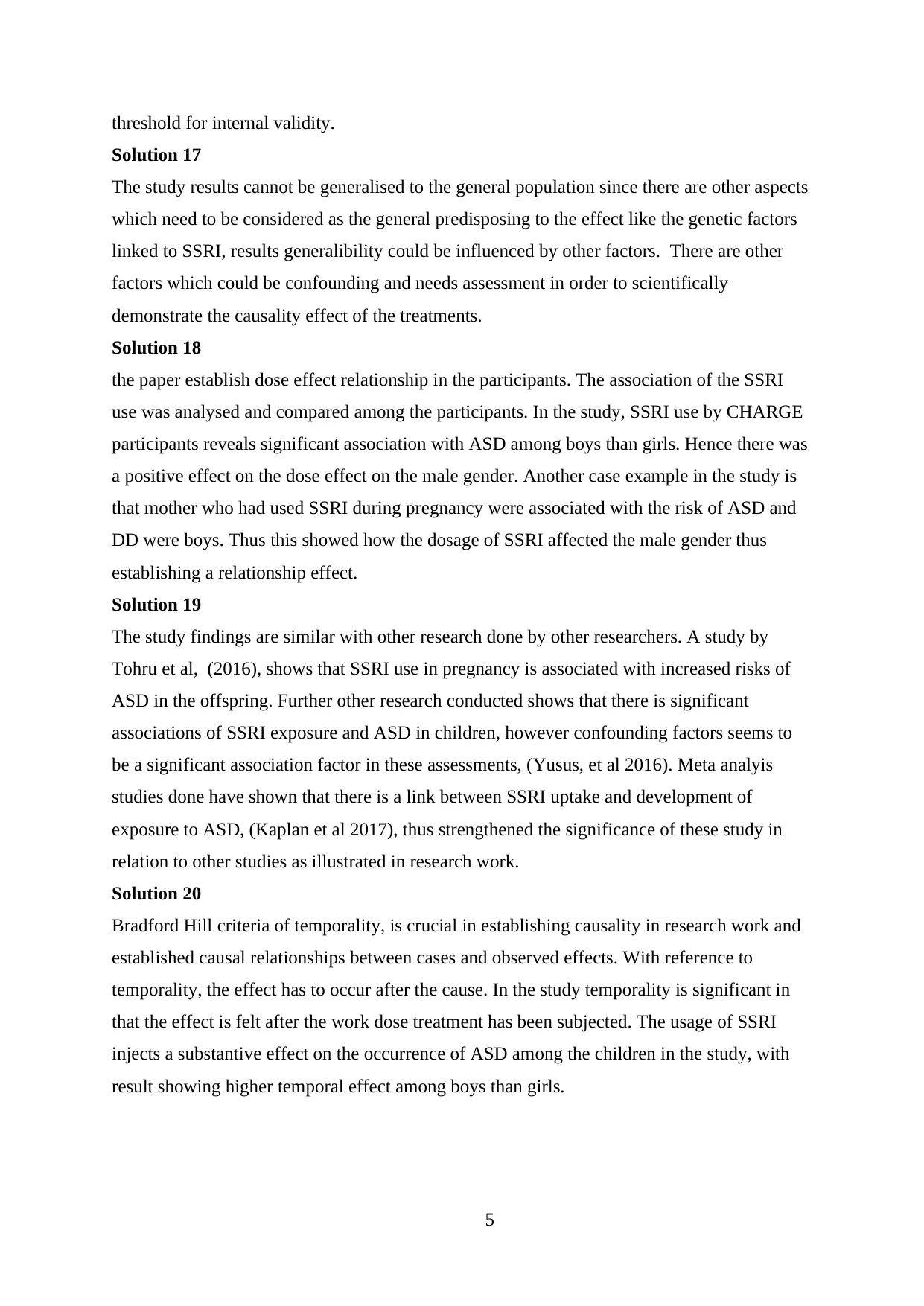
threshold for internal validity.
Solution 17
The study results cannot be generalised to the general population since there are other aspects
which need to be considered as the general predisposing to the effect like the genetic factors
linked to SSRI, results generalibility could be influenced by other factors. There are other
factors which could be confounding and needs assessment in order to scientifically
demonstrate the causality effect of the treatments.
Solution 18
the paper establish dose effect relationship in the participants. The association of the SSRI
use was analysed and compared among the participants. In the study, SSRI use by CHARGE
participants reveals significant association with ASD among boys than girls. Hence there was
a positive effect on the dose effect on the male gender. Another case example in the study is
that mother who had used SSRI during pregnancy were associated with the risk of ASD and
DD were boys. Thus this showed how the dosage of SSRI affected the male gender thus
establishing a relationship effect.
Solution 19
The study findings are similar with other research done by other researchers. A study by
Tohru et al, (2016), shows that SSRI use in pregnancy is associated with increased risks of
ASD in the offspring. Further other research conducted shows that there is significant
associations of SSRI exposure and ASD in children, however confounding factors seems to
be a significant association factor in these assessments, (Yusus, et al 2016). Meta analyis
studies done have shown that there is a link between SSRI uptake and development of
exposure to ASD, (Kaplan et al 2017), thus strengthened the significance of these study in
relation to other studies as illustrated in research work.
Solution 20
Bradford Hill criteria of temporality, is crucial in establishing causality in research work and
established causal relationships between cases and observed effects. With reference to
temporality, the effect has to occur after the cause. In the study temporality is significant in
that the effect is felt after the work dose treatment has been subjected. The usage of SSRI
injects a substantive effect on the occurrence of ASD among the children in the study, with
result showing higher temporal effect among boys than girls.
5
Solution 17
The study results cannot be generalised to the general population since there are other aspects
which need to be considered as the general predisposing to the effect like the genetic factors
linked to SSRI, results generalibility could be influenced by other factors. There are other
factors which could be confounding and needs assessment in order to scientifically
demonstrate the causality effect of the treatments.
Solution 18
the paper establish dose effect relationship in the participants. The association of the SSRI
use was analysed and compared among the participants. In the study, SSRI use by CHARGE
participants reveals significant association with ASD among boys than girls. Hence there was
a positive effect on the dose effect on the male gender. Another case example in the study is
that mother who had used SSRI during pregnancy were associated with the risk of ASD and
DD were boys. Thus this showed how the dosage of SSRI affected the male gender thus
establishing a relationship effect.
Solution 19
The study findings are similar with other research done by other researchers. A study by
Tohru et al, (2016), shows that SSRI use in pregnancy is associated with increased risks of
ASD in the offspring. Further other research conducted shows that there is significant
associations of SSRI exposure and ASD in children, however confounding factors seems to
be a significant association factor in these assessments, (Yusus, et al 2016). Meta analyis
studies done have shown that there is a link between SSRI uptake and development of
exposure to ASD, (Kaplan et al 2017), thus strengthened the significance of these study in
relation to other studies as illustrated in research work.
Solution 20
Bradford Hill criteria of temporality, is crucial in establishing causality in research work and
established causal relationships between cases and observed effects. With reference to
temporality, the effect has to occur after the cause. In the study temporality is significant in
that the effect is felt after the work dose treatment has been subjected. The usage of SSRI
injects a substantive effect on the occurrence of ASD among the children in the study, with
result showing higher temporal effect among boys than girls.
5
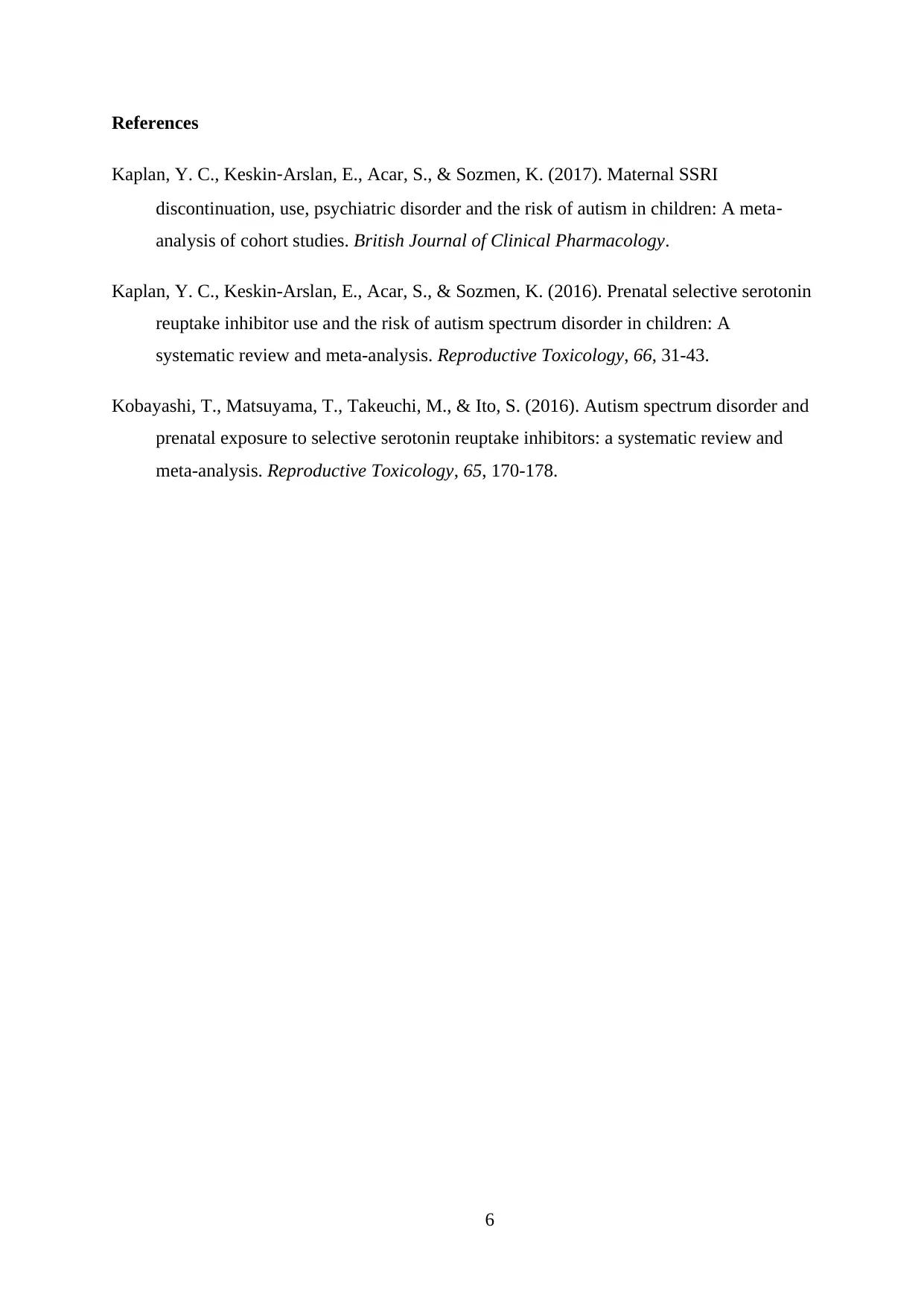
References
Kaplan, Y. C., Keskin‐Arslan, E., Acar, S., & Sozmen, K. (2017). Maternal SSRI
discontinuation, use, psychiatric disorder and the risk of autism in children: A meta‐
analysis of cohort studies. British Journal of Clinical Pharmacology.
Kaplan, Y. C., Keskin-Arslan, E., Acar, S., & Sozmen, K. (2016). Prenatal selective serotonin
reuptake inhibitor use and the risk of autism spectrum disorder in children: A
systematic review and meta-analysis. Reproductive Toxicology, 66, 31-43.
Kobayashi, T., Matsuyama, T., Takeuchi, M., & Ito, S. (2016). Autism spectrum disorder and
prenatal exposure to selective serotonin reuptake inhibitors: a systematic review and
meta-analysis. Reproductive Toxicology, 65, 170-178.
6
Kaplan, Y. C., Keskin‐Arslan, E., Acar, S., & Sozmen, K. (2017). Maternal SSRI
discontinuation, use, psychiatric disorder and the risk of autism in children: A meta‐
analysis of cohort studies. British Journal of Clinical Pharmacology.
Kaplan, Y. C., Keskin-Arslan, E., Acar, S., & Sozmen, K. (2016). Prenatal selective serotonin
reuptake inhibitor use and the risk of autism spectrum disorder in children: A
systematic review and meta-analysis. Reproductive Toxicology, 66, 31-43.
Kobayashi, T., Matsuyama, T., Takeuchi, M., & Ito, S. (2016). Autism spectrum disorder and
prenatal exposure to selective serotonin reuptake inhibitors: a systematic review and
meta-analysis. Reproductive Toxicology, 65, 170-178.
6
⊘ This is a preview!⊘
Do you want full access?
Subscribe today to unlock all pages.

Trusted by 1+ million students worldwide
1 out of 6
Related Documents
Your All-in-One AI-Powered Toolkit for Academic Success.
+13062052269
info@desklib.com
Available 24*7 on WhatsApp / Email
![[object Object]](/_next/static/media/star-bottom.7253800d.svg)
Unlock your academic potential
Copyright © 2020–2025 A2Z Services. All Rights Reserved. Developed and managed by ZUCOL.





